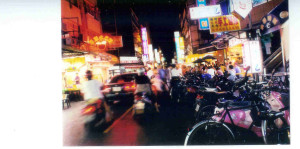I feel a pulsing and paradoxical sense of expanse and suppression as passersby move towards and immediately away. Every so often I am forced to veer as a meandering person obstructs my path. When I find my pathway unobstructed I take long strides across the sidewalks. The discordant rhythm of trolley bells, street artists, clanging coins in the bottom of a metal cup quicken my pace. I feel a closing-in of space, people coming together and falling apart, isolation, fog, golden gates of possibility, communitas. The history, the moving bodies and the identities I encounter condition the choreography I experience and my personal understanding of San Francisco.

Photo by Kenneth Speirs
SanSan Kwan’s recently published book, Kinesthetic City inspired this embodied account of my experience walking San Francisco streets. Kwan, Assistant Professor in the Theater, Dance and Performance Studies Department at UC Berkeley, spent the last decade recording her embodied memories of Chinese urban spaces, researching concert dance emerging from these sites, and analyzing the sociopolitical undercurrents of urban space and Chinese diasporic identity. Focusing on five Chinese urban communities, Kinesthetic City suggests that Chinese identity in these urban centers is mobile, and felt, rather than clearly defined through boundaries, cultural norms or politics. Through a unique methodology that combines personal reflections of embodied experience with research and analysis of staged dance works, politics and culture, Kwan creates a written choreography of cities and reveals an exchange between bodies, space, time and identity. Ultimately Kwan crafts an evocative depiction of Chinese identity that the reader viscerally feels and imagines.
In late March I met with Kwan at UC Berkeley to further discuss her unique writing process for Kinesthetic City. Kwan described her method as recursive and one that calls to mind dance anthropologist, Sally Ann Ness’ idea of “re-dash-membering.” Kwan describes this as a choreographic process of participant observation in which one enters a culture and learns how that culture moves in order to then “ingest that kinesthetic experience into her own experience and understanding, kinesthetically- like a dancer learning choreography.” In Kinesthetic City Kwan understands her writing as choreography, “a piecing together of moving parts into a consciously designed whole.”1 Thus, Kwan described her choreography as a mutual exchange between an individual and space whereby “bodies become choreographed by a collectivity of animate and inanimate objects in space…Bodies choreograph space; space choreographs bodies.”2 Kinesthetic City reveals this interplay of people and space, suggesting that the urban spaces we inhabit condition our movement and are a physical expression of cultural identity. In her three central chapters on Taipei, Hong Kong and New York City’s Chinatown, Kwan explores how choreography of a city reflects, resists or calls into question prevailing understandings of culture and identity.
Kwan’s understanding of the interplay between city spaces and identities is most apparent in the chapter, “Vibrating with Taipei,” which explores the mutual exchange between an evolving understanding of nationalism within Taiwan, choreography in the streets of Taipei, and that of Cloud Gate Dance Theatre, a national dance company of Taiwan. Kwan opens her chapter with a kinesthetic description of Taipei’s streets. From Kwan’s evocative descriptions the reader envisions Taipei’s streets as a bustling, boundary-less flurry of people and transportation, which, she writes, “move together around and among each other- loosely, fluidly, ceaselessly,”3 During our interview Kwan described how the infrastructure of Taiwan changed dramatically with Taiwan’s evolving economic climate throughout the second half of the 20th century. From a city of alleys and only a few streets that could accommodate cars, Taipei emerged into a thriving economic power—necessitating a change of infrastructure—and thus a change in the way the city moved.

Kwan relates her unique kinesthetic experience in Taipei to what she describes as an unrecognizable and evolving national culture. According to Kwan, Taiwan’s complicated political history with China creates an ambiguous identity for the Taiwanese, as citizens do not fully identify as Chinese nor wholly as non-Chinese. The work of Cloud Gate Dance Company navigates this ambiguous Taiwanese identity, offering work that represents the cultural and political underpinnings of an evolving and shifting culture. Kwan describes how Cloud Gate’s work, Legacy—a piece which tells the story of the first settlers on Taiwan’s shores—embodies choreodiplomacy; the meaning of the piece shifts and evolves depending on the venue, audience and era in which it is performed. Legacy evolves over time to serve both separatist and pro-China political resonances, inviting the audience to celebrate a shared historical experience. While Legacy embodies the shifting spectrum of political and nationalist understanding in Taiwan through links to history, Cloud Gate’s more recent work, Moonwater, embodies the kinesthetic experience of inhabiting the ever-changing Taipei of today.
Throughout Kinesthetic City Kwan returns to this idea of evolving political and economic climates impacting city movement, and thereby influencing a shift in national understanding of identity. During our interview, Kwan described how economic growth and political change “hugely affect the infrastructure, the buildings, the transportation networks and the way people move, feel and understand the city.” According to Kwan, this shift is especially apparent in regards to Hong Kong, a city that underwent massive economic growth over a period of 100 years. In her chapter on Hong Kong she contends that the city’s colonial past and current role in the global capitalist economy threaten the “disappearance” or floating quality of the city. Hong Kong’s choreography is characterized by a liquid quality of structured, efficient mobility, of people who move up escalators and disappear into the sky. Movement and dance within the city reveal a critique on this ephemeral, fleeting identity. Concert dance of the Revolutionary Pekinese Opera in Hong Kong reveals the need to challenge this disappearance. The choreography offers moments of stillness, materiality and what Kwan describes as “jaggedness” and “sparse repetition” From Kwan’s perspective this choreographic method offers the audience a moment to pause and catch hold of the ephemeral Chinese national identity in an era when global capitalism threatens to overtake the national character of the city.
Kwan describes how an influx of technology and globalization creates more virtual exchange, “closing the felt distance between places—though proximally, the distance between places is the same.” In her chapter on New York’s Chinatown, Kwan explores how Chinatown’s post 9/11 experience of disconnection from the city and markets triggered a re-imagining of Chinatown as not merely an ethnic enclave but as an area of Chinese global exchange. In the aftermath of 9/11, Chinatown faced isolation from the rest of the city, as the region was depicted as a self-separated entity from America.
Chen and Dancers, a company based in NYC Chinatown, staged Apple Dreams, a work which challenges this isolationism of the American identity, and envisions the city after 9/11 as a more integrated cohesive community. Kwan considers Apple Dreams as a dance of border crossing, in which dancers and community members of many different cultural backgrounds, ages and socioeconomic status, intermingled and were woven between one another, suggesting a more cosmopolitan and globalized identity. Kwan perceives that the work thus re-imagines isolation of Chinese identity in New York and offers a vision of this identity in a more globalized, mutually dependant world, characteristic of the 21st century.
Kinesthetic City is striking for the way Kwan weaves vivid portraits of urban movement with research, socio-political analysis and dance. Her descriptions of city choreography create complex dances in my minds eye. I visualize her experience in the streets and the intermingling motion of bodies. This vivid description of personal feeling and experience, in contrast to the research-based analysis is gripping and engaging. Kwan describes her writing process as “dialectical and recursive.” Through processes of visualizing, remembering and experiencing motion, Kwan crafts a deep reflection on Chinese identity and the politics and ideologies of urban space.
Notes:
1. Kwan, SanSan. Kinesthetic City: Dance and Movement in Chinese Urban Spaces. Oxford: Oxford UP, 2013.13-14. Print.
2. Kwan, SanSan. Kinesthetic City: Dance and Movement in Chinese Urban Spaces. Oxford: Oxford UP, 2013. 4. Print.
3. Kwan, SanSan. Kinesthetic City: Dance and Movement in Chinese Urban Spaces. Oxford: Oxford UP, 2013. 29. Print.


